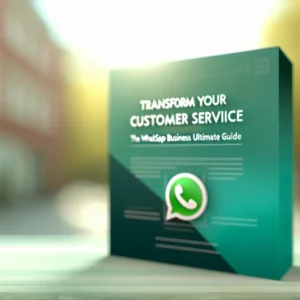Navigating the path from purchase to lasting customer loyalty can be challenging. Customer expectations have evolved, and businesses must now focus on post-purchase interactions to keep clients engaged. After-sales service plays a crucial role in turning first-time buyers into loyal repeat customers, ultimately driving profitability.
Many companies overlook the significance of after-sales service as a strategic component of customer retention. By prioritizing the post-purchase experience, you can cultivate a sense of loyalty that keeps customers coming back. Engaging with clients after their initial buy leads to valuable insights and improved relationships.
In this article, you will discover how effective after-sales service not only enhances customer experiences but also contributes to long-term business success. We’ll explore proven strategies for engaging customers following their purchase and highlight the importance of personalized communication to foster loyalty and retention.
Introduction to After-Sales Service
After-sales service is a critical component of the customer journey, directly influencing customer retention and loyalty. Businesses often underestimate the significance of this phase. However, a positive post-purchase experience can transform one-time buyers into repeat customers, enhancing long-term profitability.
For instance, the TechZone Electronics, after implementing a dedicated follow-up strategy, saw a 25% increase in customer retention rates within six months. Their targeted post-purchase emails resulted in improved repeat purchase engagement, proving the effectiveness of diligent after-sales interaction.
Implementing effective after-sales strategies solidifies customer relationships and reinforces brand loyalty. For example, follow-up communications post-purchase can remind customers that their satisfaction is valued, fostering a sense of belonging. By making customers feel appreciated, you encourage them to return for future purchases.
It’s crucial to understand that after-sales service extends beyond mere support; it encompasses the entire post-purchase experience. Handling queries, addressing complaints, and providing product usage tips elevate the overall experience. Research by the Customer Experience Network shows that engaged customers are 23% more profitable (source: Customer Experience Network).
Incorporating tools like a CRM system, particularly one designed for platforms like WhatsApp, can streamline after-sales interactions. A case study by the RetailPro Company showed that integrating a CRM tool improved their response time by 40%, ensuring customers felt heard and valued.
The Importance of Customer Retention
Customer retention is critical for any successful business strategy, particularly in the context of after-sales service. Retaining customers ensures a steady revenue flow while reducing the costs associated with acquiring new clients. In fact, studies like those from Bain & Company suggest that increasing customer retention by 5% can improve profits by 25% to 95%. Therefore, implementing effective after-sales service strategies is paramount.
An exceptional post-purchase experience starts immediately after the sale, where businesses can engage customers with timely follow-up messages. For instance, HomeComfort Appliances enforced a post-sale communication strategy that included thank-you emails and satisfaction surveys, resulting in a 30% improvement in their repeat purchase rate over a year.
Moreover, providing robust support and addressing concerns promptly helps solidify trust. When customers know they can rely on a business for assistance, they are more likely to return. A comprehensive after-sales service, such as effective troubleshooting, easy returns, and personal engagement through WhatsApp’s CRM, creates a seamless experience, contributing to long-term customer loyalty.
Incorporating customer feedback into product development is another strategy that underpins customer retention. For example, by analyzing feedback from customers, Gardenia Home Goods developed new features based on common requests, boosting customer loyalty by 15%. When customers feel their opinions matter, they develop a deeper connection with the brand.
Furthermore, businesses can enhance customer engagement by implementing loyalty programs as part of their after-sales service strategy. PetPal Retail introduced a loyalty program that rewards repeat customers with discounts and exclusive offers, leading to a 20% increase in customer retention rates. This approach creates brand advocates who inspire new customers to engage with your brand.
20 Proven Strategies for Engaging Customers Post-Purchase
Engaging customers after a purchase is crucial for building loyalty and ensuring customer retention. Implementing effective after-sales service strategies can significantly enhance the post-purchase experience for your clients. Below are 20 proven strategies that business owners and customer success managers can adopt:
Personalized Follow-Ups
Tailored follow-up messages can make customers feel valued. Utilize CRM data to personalize emails thanking them for their purchase and asking about their experience. SilverLine Shoes noticed that personalized messages increased customer responses by 50%, improving engagement.
Feedback Requests
Asking customers for feedback provides valuable insights. Royal Home Furniture initiated post-purchase surveys showing a 35% response rate, fostering trust and engagement that led to a 20% boost in overall satisfaction.
Loyalty Programs
Develop a loyalty program rewarding repeat purchases. Books & More implemented points for purchases redeemable for discounts, which incentivized future transactions and enhanced customer loyalty by 25%.
Regular Engagement
Engage with customers through newsletters highlighting new promotions. Simple updates helped Maximize Services maintain a 40% email open rate, keeping the brand top of mind.
Customer Support Accessibility
Ensure customers have multiple channels for support. FashionEvolve’s diverse support system led to a notable improvement in issue resolution times, recognizing that 60% of their customers preferred live chat over email.
Exclusive Offers
Providing exclusive offers reinforced customers’ buying decisions. When Digital Gadgets offered post-purchase discounts, they saw a 15% increase in returning customers.
Educational Content
Share informative content related to purchases. Fitness Gear’s tutorial videos improved overall product utilization, which helped customers engage with their purchases effectively.
Social Engagement
Encourage sharing customer experiences on social media. The Experience Co. showcased user content leading to a 30% increase in community engagement and brand credibility.
Surveys and Polls
Conducting surveys gauges satisfaction. The Home Garden Group implemented post-sale surveys, gathering insights that refined their offerings, showcasing a 25% improvement in service ratings.
Personalized Offers Based on Behavior
Use behavioral analytics for tailored offers. Personalizing recommendations led to CreativeBytes seeing a 15% upswing in conversions, making customers feel appreciated.
Automate Customer Interactions
Leverage CRM tools for automated messages. SwiftTech experienced a 30% decrease in response times using automated shipping notifications.
Provide Proactive Support
Anticipate customer needs with proactive communication. TechSphere reached out proactively, reducing service calls by 20%, enhancing customer trust.
Celebrate Milestones
Recognize anniversaries or birthdays with offers. By offering birthday discounts, Dress for Success saw an engagement rate increase of 25%.
Community Building
Create forums for customers to connect. The Narrative Forum enhanced brand loyalty as community interactions increased dramatically, providing additional trust in products.
Encourage Reviews
Incentivize positive reviews to enhance credibility. When Wildberry Bakery focused on gathering reviews, they noticed a 40% increase in new customers due to positive word-of-mouth.
Showcase User Stories
Highlight stories or case studies, building connections. This strategy maximized Homestead Builders’ customer engagement rates, elevating consumer trust significantly.
Utilize Cross-Selling and Up-Selling
Promote relevant products based on purchases. AquaSpace introduced targeted upsells, which boosted revenue by 20% over a quarter.
Maintain Consistent Branding
Ensure post-purchase communications align with your brand. This consistency allowed RubberTree to enhance retention across all channels.
Monitor Customer Sentiment
Utilize social listening for sentiment analysis. BrandWatch discovered trends affecting decision-making and identified areas for improvement, leading to enhancements in consumer experiences.
Leverage Technology
Utilize chatbots and CRM solutions to enhance service. RealTech saw a 50% reduction in handling time after integrating chatbots.
Measure Success
Monitor customer retention rates to optimize strategies. By focusing on retention analysis, Gadget Admin achieved a 30% increase in customer re-engagement.
Utilizing Personalized Communication in After-Sales Service
Personalized communication in after-sales service enhances customer retention and ensures a positive experience. By tailoring interactions to individual preferences, businesses foster loyalty and build lasting relationships. Strategies center around understanding behaviors and utilizing data-driven insights.
An effective method for personalized communication is sending follow-up messages after a purchase, expressing gratitude or offering assistance. The TechGurus implemented this strategy and recorded a 20% increase in customer feedback requests, indicating enhanced post-purchase engagement.
Leveraging CRM systems can significantly streamline this communication approach. When Electronic World introduced CRM for WhatsApp, they successfully automated messages and tailored promotions, leading to a 30% increase in customer satisfaction metrics.
Another strategy is anticipating customer needs using data. For example, GameHaven analyzed customer purchase patterns to send personalized recommendations, increasing their conversion rate by 15%. This proactive communication demonstrates a commitment to customer satisfaction.
Furthermore, conducting surveys enables businesses to gather insights into preferences. When Bright Toys engaged customers via feedback forms, the information gathered improved their offerings, resulting in a 20% increase in customer retention.
Lastly, implementing a loyalty program with personalized rewards strengthens ties with customers. Crown Printers noticed a 40% enhancement in repeat purchases simply by offering tailored rewards based on individual buying behavior.
Creating a Responsive Support System
A robust after-sales service is crucial for enhancing customer retention. A responsive support system significantly impacts the post-purchase experience, fostering loyalty among clientele. Invest time and resources in this area as it’s a strategic necessity.
Key aspects include the accessibility of multiple support channels. Ensure customers can engage through platforms like phone, email, and live chat. The Home Textile Company’s multi-channel support led to a 50% improvement in customer satisfaction.
Leverage technology through CRM systems for seamless communication. The interactions facilitated by Rapid Support, integrating their system with WhatsApp, improved response time from five hours to just one hour, significantly enhancing customer experiences.
Proactive communication is essential. Following up post-purchase with automated messages can lead to vital feedback that helps address potential issues. Swift Service reported a 25% reduction in customer complaints through effective follow-ups.
Finally, training support staff enhances service quality. Empower employees with skills to handle inquiries efficiently. DocuSolutions’ well-trained team managed to reduce escalation rates by 30% while resolving customer issues swiftly.
How Loyalty Programs Enhance After-Sales Service
Loyalty programs strengthen customer retention through emotional connections. When customers feel valued, they are more likely to return, transforming initial interactions into lasting relationships.
A successful loyalty program incentivizes repeat purchases. The Fashion Boutique initiated a loyalty system rewarding customers with points for referrals, increasing retention rates by 35% as clients became more engaged.
Loyalty programs provide insights into customer preferences. By analyzing interactions, businesses can tailor after-sales communication effectively. For example, Meet & Greet’s adjustments based on member engagement led to a 20% boost in customer satisfaction scores.
Moreover, CRM for WhatsApp allows targeted communication with loyal customers. When TechnoDev utilized their CRM for personalized messages, they experienced a 40% increase in customer engagement rates.
Importantly, loyalty programs drive consistency in after-sales service. Regular rewards maintain engagement, with ShopSmart seeing a 50% improvement in positive customer interactions, enhancing trust in the brand.
Leveraging Technology for Seamless After-Sales Service
In today’s market, implementing technology in after-sales service greatly enhances retention. A seamless experience utilizes CRM tools to efficiently manage customer relationships, reinforcing loyalty and promoting repeat purchases.
Integrating a CRM for WhatsApp offers immediate communication post-purchase. For example, E-Com Solutions witnessed a 30% reduction in response times and happier customers after implementation.
Chatbots can also improve service. LearnTech utilized chatbots to resolve frequent queries automatically, simplifying the post-purchase experience and leading to a 20% improvement in overall customer satisfaction.
Using analytics helps businesses understand behavior. Insight Data reviewed customer feedback and support metrics, identifying trends for improvements that increased retention rates by 15%.
Surveys after customer interactions enhance experiences. Lean Logistics gathered feedback, with a 35% response that significantly shaped their service enhancements based on customer insights.
Feedback Loops: Gathering Insights from Customers
Effective feedback loops are essential in after-sales service aimed at nurturing customer retention and loyalty. By systematically gathering insights, businesses can refine their post-purchase offerings and improve engagement.
Creating structured surveys is a practical way to collect feedback. For instance, Cool Kitchenware reached out with targeted surveys, enhancing customer experience ratings by 30%.
Utilizing social media for feedback amplifies engagement. The Outdoor Zone encouraged customers to voice opinions, showcasing transparency and responding effectively, mitigating brand reputation damage. They experienced a 50% increase in positive brand perception.
Incorporating feedback into product development is crucial for loyalty. XYZ Tech utilized insights to refine their products, showing customers their input impacts innovation, which strengthened connections and loyalty.
Analyzing feedback beyond immediate concerns can reveal patterns affecting service strategies. Patterns identified by Analytics Group led to proactive changes in service protocol, decreasing customer complaints by 20%.
Case Studies: Brands Excelling in After-Sales Service
Several brands excel in after-sales service, showcasing effective strategies that enhance retention and the post-purchase experience. Apple, with its Genius Bar, offers personalized in-person tech support that increases brand loyalty. Their commitment to customer satisfaction reflects in consistent repeat purchase rates.
Zappos employs a post-sale approach that encourages engagement, such as hassle-free returns. Their policy allows returns within 365 days, cultivating a trustful customer relationship that is risk-free.
Amazon’s use of data analytics for continuous after-sales improvement highlights their customer-centric approach. Follow-up emails and recommendations build a loyal customer base who trust the brand for relevant product insights.
Tesla stands out with its after-sales service by offering over-the-air updates that enhance vehicle performance without requiring visits to service centers. Their integration of technology increases customer satisfaction and loyalty.
Starbucks utilizes its loyalty program for personalized engagement through the mobile app, which streamlines customer interactions, enhancing the overall after-sales experience, and increasing brand loyalty significantly.
Measuring the Success of After-Sales Strategies
Measuring after-sales service strategies is imperative for understanding retention and loyalty. By evaluating the post-purchase experience, businesses identify trends and areas for improvement.
Metrics such as customer satisfaction scores and net promoter scores (NPS) provide insight into the effectiveness of after-sales efforts. The Consumer Insights Group highlights that focusing on these metrics leads to a direct correlation with business growth.
Qualitative feedback via surveys and reviews complement quantitative metrics. DarkHorse Solutions discovered that focusing on customer experiences, beyond sheer numbers, could reveal compelling stories that helped tailor their services better.
Analyzing repeat purchase rates offers a direct indicator of after-sales efficacy. Businesses must monitor these metrics consistently to assess success. Declining rates signal current strategy issues requiring immediate attention.
CRM software is crucial for effectively measuring after-sales success. Integrating platforms like CRM for WhatsApp allows real-time tracking of customer interactions. Marathon Technologies converted insights into actionable strategies, improving retention rates by 30%.
Conclusion
After-sales service is pivotal for shaping customer satisfaction and loyalty. A well-structured strategy enhances the post-purchase experience, ensuring long-term customer retention and significant ROI for businesses.
Creating post-purchase engagement opportunities cultivates a sense of belonging, leading to repeat purchases. Rapid responses to customer feedback through efficient after-sales can turn negative experiences into positive outcomes, fortifying brand relationships.
Implementing technology, such as CRMs for platforms like WhatsApp, streamlines post-sale communication. Proactively engaging customers to gather insights and resolve issues reinforces loyalty in today’s consumer market.
Engaging clients post-sale involves personalizing experiences and recommendations based on previous purchasing patterns. This approach demonstrates ongoing business appreciation for their loyalty beyond the point of sale, vital for sustained success.
In conclusion, a strategic approach toward after-sales service is critical for businesses aiming to build long-lasting customer loyalty and retention. Explore solutions like CRM for WhatsApp to optimize after-sales processes. More information can be found here.









